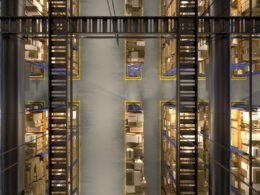The fusion of physical and digital realms has become increasingly prevalent in the rapidly evolving marketing landscape. This integration, often called ”phygital marketing”, aims to create cohesive and immersive consumer experiences across online and offline channels.
One of the key technologies driving this convergence is the humble QR code. Once overlooked, QR codes have experienced a resurgence, serving as a tool for seamlessly bridging the gap between physical and digital marketing.
In this article, we will look at what phygital means and how QR codes facilitate it in marketing.
The Rise of Phygital Marketing
As defined by TechTarget, phygital is a marketing term that indicates the blending of physical and digital experiences. As customer interaction points increase, companies are trying to seamlessly integrate phygital to offer omnichannel experiences.
Phygital marketing represents a paradigm shift in how brands engage with consumers. Traditionally, marketing efforts were confined to physical or digital channels, with limited interaction. However, as consumer behavior evolves and technology advances, businesses recognize the need to adopt a more integrated approach.
Phygital marketing seeks to create a unified brand experience, seamlessly transitioning between online and offline touchpoints. Whether through interactive displays in brick-and-mortar stores or engaging social media campaigns, the goal is to provide consumers with a cohesive journey.
Enter QR Codes: The Phygital Enabler
The QR code is at the heart of this integration. It is a versatile tool that bridges the gap between physical objects and digital content. They can redirect users to websites, videos, social media profiles, etc.
According to Plaque Direct, these QR codes can enable businesses to connect digitally and stand out. They can allow users to access information, promotions, or interactive experiences offered by any brand. This allows companies to enhance their presence with eye-catching and engaging signs.
Moreover, businesses can even incorporate personalization into them to create a long-lasting impression. For instance, they can use it with premium plaque cards to make the codes visually appealing. Additionally, they can customize the plaque cards to give personalized messages to customers.
Consider this simple example to understand the use of customized QR code plaques. Suppose you are running a small bookstore where you want to offer digital experiences to walk-in customers. In this case, you can place a customized QR code plaque in your bookstore.
When the walk-in customers scan the QR code from your physical store, they can access your digital application or website. From here, they can get a virtual store tour and personalized recommendations based on their interest.
Upon selecting a book, the online app can also help them navigate to that section in the bookstore. This will offer a memorable experience and help improve your brand presence and recognition.
Benefits of Using QR Codes for Offering Phygital Experiences
QR codes offer a multitude of benefits for both businesses and consumers. The first benefit they offer is convenience. QR codes provide a convenient way to access digital content without typing lengthy URLs or searching for information online. Therefore, their use for marketing and promotions has increased.
Taylor Swift did the same thing to pique fans’ interest in her latest album, The Tortured Poets Department. As stated by WGN 9, she put up a giant QR code on a mural in Chicago ahead of the album’s release.
Scanning the QR code takes the Swifties to a short YouTube video on her channel. The video has some hints for her fans to crack. As the QR was set up, many fans lined up to crack the message and posted it on their social media accounts.
Similarly, many businesses and individuals can use a customized QR code to their advantage to offer phygital experiences.
Another benefit of QR codes is engagement. By scanning QR codes, consumers can engage with interactive content such as product demonstrations, virtual tours, and exclusive offers, enhancing their brand experience.
Businesses can also track QR code scans to gather valuable data about consumer behavior. This can include the effectiveness of marketing campaigns, popular products, and customer demographics.
Seamless Phygital Experiences with QR Codes
The versatility of QR codes makes them an ideal tool for creating seamless phygital experiences. Here are some ways in which businesses can harness QR codes to enhance their marketing efforts:
- In-store activation: Retailers can place QR codes on product displays, allowing customers to access additional product information, reviews, and purchasing options. This enhances the shopping experience and empowers consumers to make informed purchasing decisions. An Emerald Insight study shows that sporting goods retailers are doing the same by using mobile phones, intelligent stations, sensors, etc.
- Interactive signage: Museums, galleries, and tourist attractions can use QR codes on signage to provide visitors with multimedia content. This enriches the visitor experience and encourages deeper engagement with the exhibits.
- Digital menus: Restaurants and cafes can replace traditional printed menus with QR codes. This allows customers to browse the menu, place orders, and make payments directly from their smartphones. According to Statista, 45% of adults have used a QR code at a diner to view the menu between June 2022 and 2023.
Frequently Asked Questions
Are QR Codes Still Relevant in Today’s Digital Age?
With the increasing reliance on smartphones and the growing demand for instant access to information, QR codes have become more relevant than ever. They offer a convenient and efficient way to bridge the gap between physical objects and digital content.
Can QR Codes Be Customized to Match a Brand’s Aesthetics?
Yes, QR codes can be customized with colors, logos, and other branding elements to align with a company’s visual identity. However, it’s important to ensure that the QR code’s core functionality remains intact and that it remains scannable.
Are QR Codes Secure?
While QR codes are secure, businesses must exercise caution when linking them to external content. To protect consumers from potential security threats, they should ensure that the destination URL is legitimate and free from malicious intent.
To conclude, in an increasingly connected world, integrating physical and digital marketing channels is no longer optional. It’s essential for staying competitive in today’s marketplace. QR codes are a powerful enabler of this integration, allowing businesses to create seamless, immersive experiences that captivate consumers across multiple touchpoints.
By harnessing QR codes’ potential, brands can bridge the gap between the physical and digital worlds, forge stronger connections with their audience, and drive meaningful engagement.












